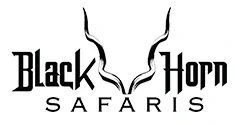Waterbuck safaris offer a unique experience for seasoned hunters. These majestic antelope species are native to sub-Saharan Africa, where they inhabit grasslands and bushveld, often residing close to rivers and bodies of water. With their distinct white rings encircling their hindquarters and impressive forward curving horns, Waterbuck are a sought after trophy and a challenge to Safari hunters. We cover everything you need to know for a hunt in South Africa including Prices, Hunting Packages and more.
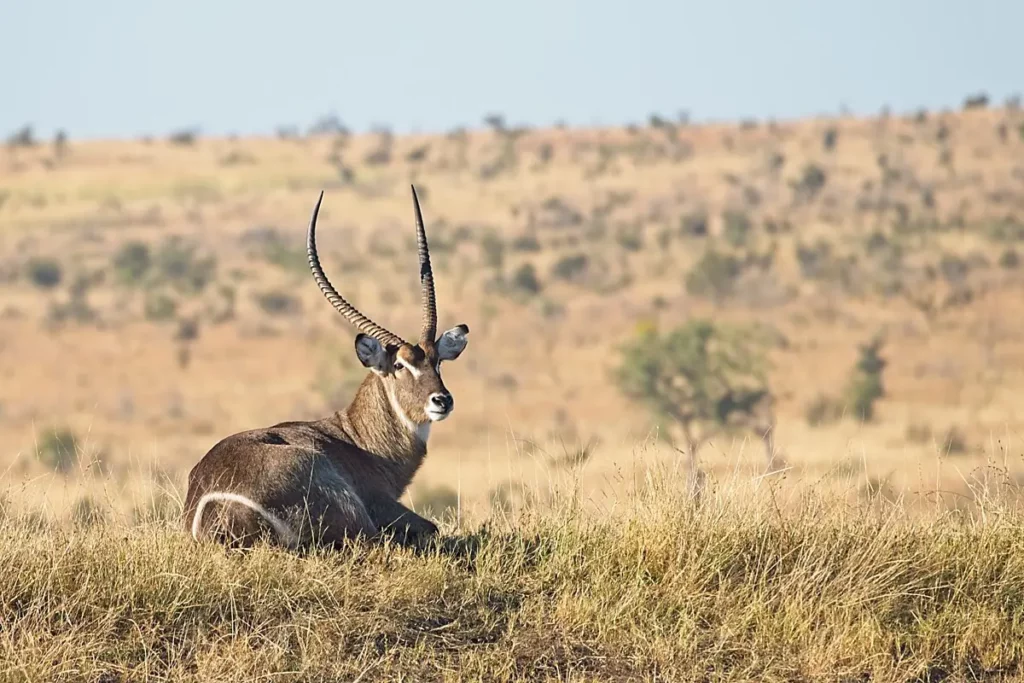
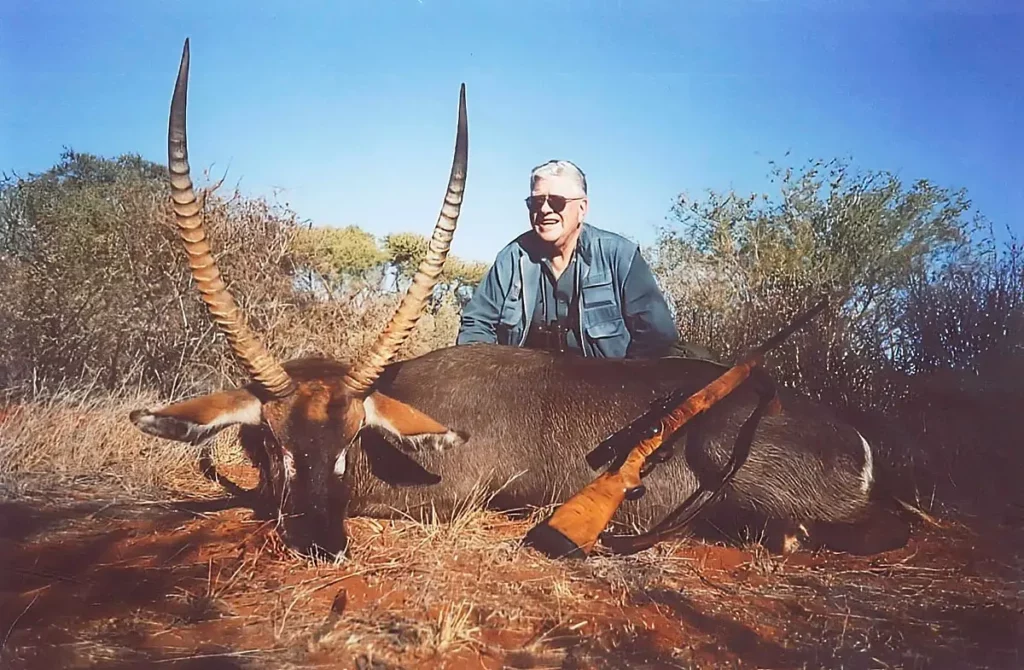
Description and Characteristics
The Waterbuck (Kobus ellipsiprymnus) is a remarkable species of antelope native to the African continent. Boasting a stocky build and a body length of approximately 4 to 7 feet, these magnificent animals stand tall, with shoulder heights ranging from 3.5 to 4.5 feet. Males tend to be significantly larger than females and can weigh anywhere between 440 and 660 pounds, while females typically weigh between 350 and 500 pounds. One of the most characteristic features of the Waterbuck is the iconic white ring encircling its rump, which serves as a prominent identification marker. The Waterbuck’s coat varies in color, from a reddish-brown to a dark gray, and its fur is notably coarse and shaggy. Males possess long, forward-curving horns that can reach up to 35 inches in length, adding to their impressive appearance. Waterbuck are highly adapted to living near water sources, as they rely on them for drinking and evading predators. Their preference for water-rich environments has resulted in the development of a unique waterproofing oil secreted by their skin glands, which helps them stay dry and protects their thick, course fur. Waterbuck emit a strong turpentine like scent, which according to local belief, serves as a deterrent to Crocodiles.
Waterbuck Trophy Size
A Waterbuck’s trophy size is primarily determined by the length and thickness of the male’s horns. Mature Waterbuck males boast impressive horns that have a deep forward curve, with an ideal trophy boasting a horn length of 28 inches or more. However, exceptional specimens can have horns extending up to 35 inches in length. The horn’s bases, which can be up to 9 inches in circumference, are another aspect contributing to the trophy size. A prime trophy Waterbuck is typically an older, dominant bull with fully developed horns and a healthy, robust appearance, reflecting the magnificent characteristics of this remarkable species. Both Rowland Ward and Safari Club International maintain record books for Waterbuck, Minimum for entry into RW is 28 inches and SCI is a score of 67.
Best Locations in South Africa
South Africa, with its diverse ecosystems and abundance of wildlife, offers some of the finest locations for Waterbuck. The Limpopo Province, located in the northernmost part of the country, is particularly renowned for its thriving Waterbuck population. This region boasts a mix of bushveld, savannas, and riverine forests, providing ideal habitats for these majestic animals. Another prime hunting destination is the Eastern Cape, where the Great Fish River Reserve and its surroundings host an impressive number of Waterbuck. The KwaZulu-Natal Province, with its lush vegetation and varied landscapes, also offers ample opportunities for hunters seeking the thrill of Waterbuck safaris. In addition to these provinces, private game reserves and hunting concessions scattered throughout the country provide well-managed Waterbuck populations. When planning a Waterbuck trip, it is essential to work with a reputable hunting outfitter and guide who prioritizes ethical hunting practices.
Rifles and Calibers for Waterbuck Hunts
Selecting the appropriate rifle hunting caliber is an important aspect of safaris, as it greatly influences the success of the hunt. Waterbuck are large, stocky animals that require a significant amount of stopping power to ensure a quick, humane kill. Generally, hunters opt for medium to large calibers when pursuing Waterbuck. Popular choices include the .30-06 Springfield, .300 Winchester Magnum and the .338 Winchester Magnum, all of which provide a combination of adequate power, precision, and manageable recoil. When it comes to bullet selection, it is essential to choose a premium, controlled-expansion bullet that offers optimal weight retention and penetration. Bullet weights of 180-220 gr. are recommended for adequate performance.
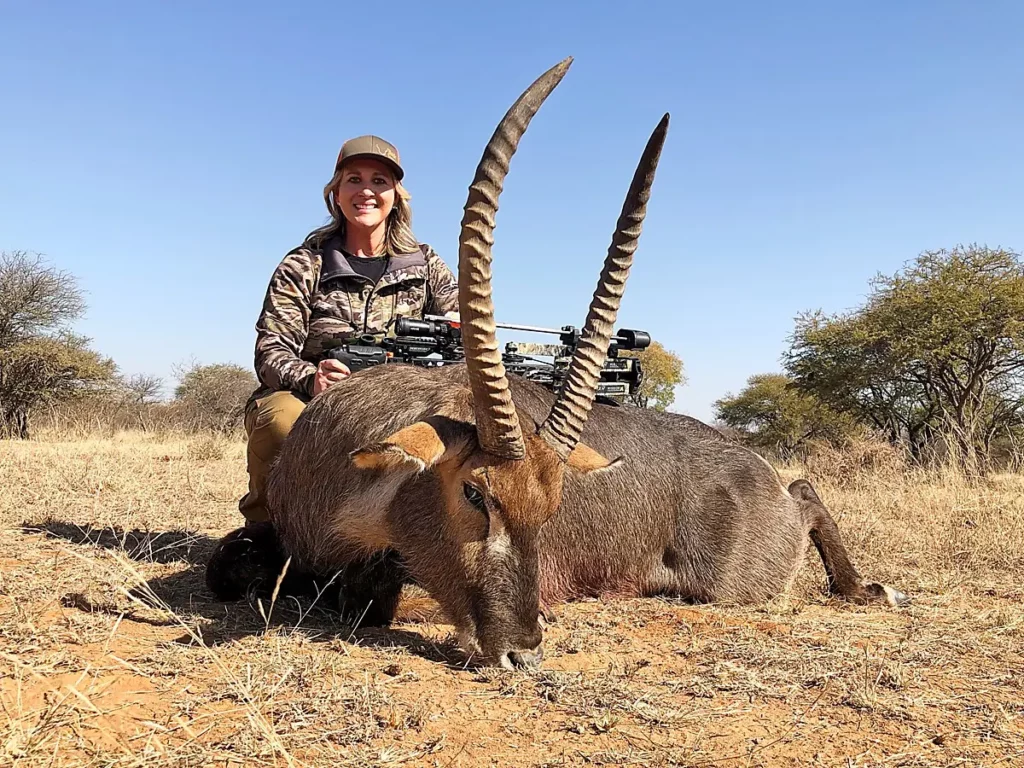

Rifle Scopes for Hunting Waterbuck
Equipping your rifle with the right scope significantly enhance your experience. When selecting a scope, it is essential to consider factors such as magnification, objective lens diameter, and overall build quality.
A variable magnification scope, ranging from 3-9x or 4-12x, is generally recommended for hunting Waterbuck, as it offers the flexibility to adjust the magnification based on the shooting distance. The objective lens diameter should ideally be between 40mm and 50mm, as this ensures adequate light transmission for clear, bright images in varying light conditions, which is particularly important during an early morning or late afternoon Waterbuck hunt.
It is essential to choose a scope with a durable and weather-resistant construction, as hunting often takes place in harsh environments with fluctuating weather conditions. Opting for a scope with a rugged build, waterproof and fog-proof features, and reliable turret adjustments will ensure optimal performance. Investing in a high-quality scope and optics will not only improve your chances of success but also contribute to a more enjoyable Waterbuck experience.
Best Shot Placement
When hunting Waterbuck, ethical shot placement is of the utmost importance, as it ensures a quick, kill while minimizing the chances of wounding or losing the animal. The most effective shot placement for Waterbuck is the high shoulder or heart-lung shot, which targets the vitals. To execute this shot, aim for a point one third up from where the middle of the front leg intersects with the the animal’s body when it’s standing broadside. This area contains the heart, lungs, and major blood vessels, and a well-placed shot here will result in a quick, clean kill.
Another effective shot is the neck shot, which targets the spinal cord and will instantly incapacitate the animal. However, this shot requires a higher level of skill and precision due to the smaller target area and the risk of wounding the Waterbuck if the shot is misplaced.
Regardless of the shot placement, it is essential for hunters to exercise patience and wait for the ideal opportunity, ensuring that they have a clear, stable shooting position and a broadside or slightly quartering-away angle.
Bow Hunting Waterbuck
Bow hunting Waterbuck offers an exhilarating and challenging alternative to traditional rifle hunting, requiring exceptional skill, stealth, and patience. As Waterbuck possess keen senses and are notoriously elusive, bow hunters must be adept at stalking their quarry and getting within close range, typically 20 to 40 yards, to ensure an effective, ethical shot.
Shot placement is crucial when bow hunting Waterbuck; the preferred point of aim is for the heart-lung area, just behind the shoulder in the bottom third of the animal’s body when it is standing broadside. This shot placement maximizes the chances of hitting vital organs, resulting in a swift death.
Most Waterbuck hunted with archery equipment in South Africa are shot from either a ground blind or tree stand over water or feed.
Bow Hunting Equipment
When planning a Waterbuck bow hunt, it is essential to equip yourself with the right gear to ensure a successful and ethical hunt. Select a high-quality compound, recurve, long bow or crossbow with a minimum draw weight of 60 to 70 pounds. Waterbuck are large and stout animals that require a reasonable amount penetration for a clean kill.
For arrows choose durable shafts made of carbon fiber, which provide optimal stability and penetration. Arrows should be matched to your bows poundage and your draw length. Arrow weight should be between 450 and 550 gr. Broad heads should be either fixed blade or reliable mechanical open on contact type of around 125 gr. Broad heads need to be razor sharp with a cutting diameter of one and a quarter to one and a half inches. This type of set up should easily penetrate through the ribs and lungs and result in a beautiful Waterbuck trophy.

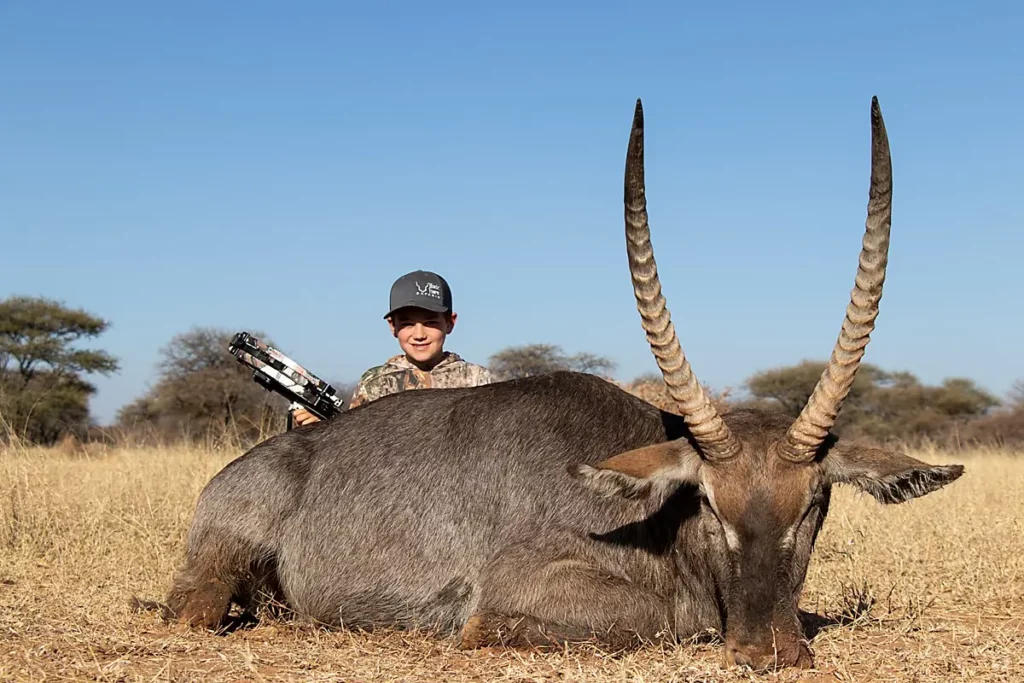
Waterbuck Prices and costs of a Hunting Safari
The trophy fee or price for a Waterbuck is $ 2700.
Daily rates for a Waterbuck Safari are:
- Hunting 2 on 1 (2 hunters sharing a Professional Hunter) @ $ 350 per hunter per day.
- Hunting 1 on 1 (the hunter has the services of the Professional Hunter to himself) @ $ 450 per hunter per day.
The daily rates include:
- Accommodation in a hunt lodge
- Meals
- Drinks
- The services of a Professional Hunter and his tracker
- Field preparation of trophies
- Delivery of trophies to the Taxidermist
- Road transportation to and from Johannesburg International Airport
Waterbuck – Hunting Packages
A Waterbuck and plains game – hunting package with three other species costs $ 7 200.
This package includes the trophy fee for 1 X Waterbuck, 1 X Blue Wildebeest, 1 X Impala and 1 X Warthog and the day rate for 7 days of hunting.
FAQ’S Frequently asked Questions
How much does it cost to hunt a Waterbuck in South Africa?
The trophy fee to hunt a Waterbuck in South Africa costs $ 2700. This price excludes the daily rate of $ 350 per hunter per day. The daily rate includes accommodation, meals, drinks, the services of a professional hunter, field preparation of your trophies and road transportation to and from Johannesburg International Airport.
What rifle caliber is best for Waterbuck?
The best rifle caliber for Waterbuck is the 300 Winchester magnum. The 300 Winchester caliber provides sufficient power and accuracy to take down a waterbuck humanely, given their size and robust build. When selecting a rifle caliber, it is important to consider the balance between adequate stopping power and manageable recoil. This caliber should be paired with premium controlled expansion bullets such as Nosler Partition or Barnes TSX weighing 180 gr for best results.
Where is the best place to hunt Waterbuck?
The Limpopo Province, located in the northernmost part of South Africa, is particularly renowned for its thriving Waterbuck population. This region boasts a mix of bushveld, savannas, and riverine forests, providing ideal habitats for Waterbuck. The Limpopo Province routinely produces the best trophy quality Waterbuck in the country.
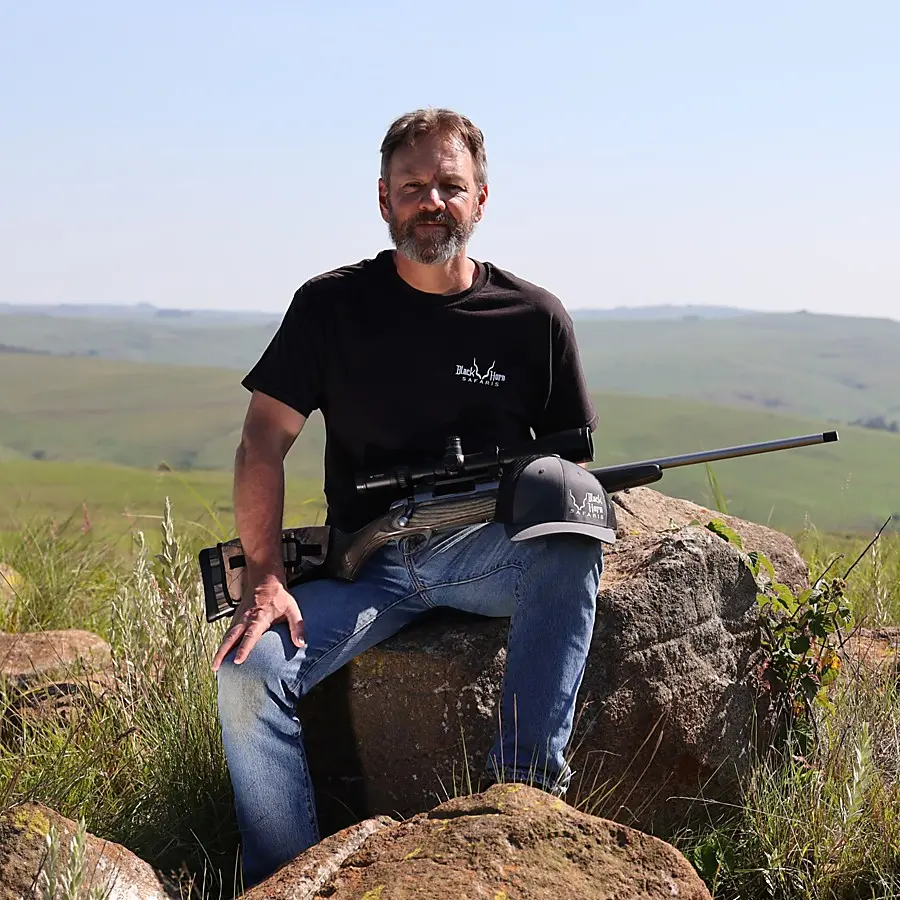
Adrian Anderson first obtained his Professional Hunters license in 1991. He is a Big Five and Dangerous Game licensed Professional Hunter and Hunting Outfitter. He has a tremendous love for wildlife and the African bush and enjoys sharing his knowledge with the hunting clients that he guides. Guiding hunters in Africa’s wild places is a passion and seeing them succeed with their goals brings satisfaction. With knowledge of the Safari industry built up over 32 years he is well qualified to give guidance to his hunting clients.
